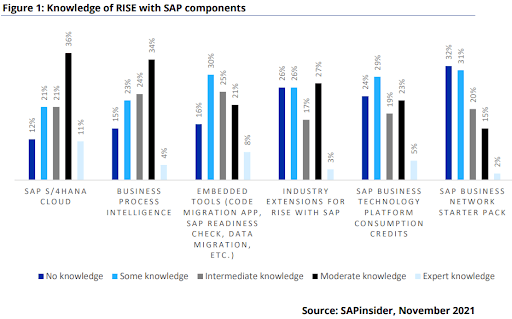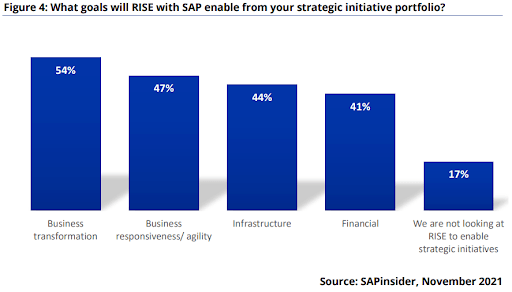RISE with SAP – After a year, what do customers really think?
In January 2021, SAP announced RISE with SAP. With a little over a year into the RISE offering, let’s look at its impact on the SAP customer base, what customers know, and how they feel about RISE with SAP.
For starters, let’s be clear on what RISE with SAP is. RISE with SAP is not a product; it is an offering. RISE with SAP is actually a bundle consisting of SAP S/4HANA Cloud, cloud infrastructure, business process intelligence (from SAP’s Signavio acquisition), technical services for the transition process, minor support services, and some credits for SAP Business Technology Platform (SAP BTP – a rebranding of SAP Cloud Platform), all rolled into a single contract. SAP refers to RISE with SAP as Business Transformation-as-a-Service (BTaaS), something that goes beyond a Software-as-a-Service or Infrastructure-as-a-Service offering, that it’s everything you need to run the intelligent enterprise in a single bundle.
Confused yet? Don’t worry; you’re not alone. When SAP announced RISE with SAP in January 2021, it left the SAP community with the same confusion. The echoes of What? Where? Why? How? questions could be heard everywhere, and truthfully even SAP didn’t have all the answers at first. But SAP has made RISE with SAP a priority since its release. Data from an SAP Insider Nov. 2021 survey shows at least a quarter of respondents had no knowledge of RISE’s components.

What adds to the confusion is that each of RISE with SAP’s components is their own independent offering from SAP and can still be consumed separately today. Therefore, not only do SAP customers need to understand each component, they need to understand how RISE with SAP bundles these components together to create this new solution.
A Nov. 2021 survey by UK & Ireland SAP User Group (https://www.sapusers.org/news/996/main-driver-for-using-rise-with-sap-is-accelerating-the-move-to-s4-hana-according-to-uk-and-ireland-sap-user-group-survey) found that while 44% were at least somewhat familiar with RISE, 30% had never heard of it! This illustrates that there is still a lot of work to educate users about precisely what RISE with SAP is and what it includes.
Education should remain a significant focus for SAP in 2022.
So what is driving interest in RISE with SAP?
While most organizations that are running SAP deal with the cross-roads of ECC support ending on the horizon, RISE with SAP is a natural point of interest. Most ECC customers are either making or will soon move to S/4HANA.
RISE with SAP is one way to get to S/4HANA. In addition, most organizations are taking the time to consider their next-gen platform and infrastructure where S/4HANA will live, so naturally, the cloud conversation comes into play, which again, RISE with SAP is one option. So naturally, to help justify the cost of going to S/4HANA, organizations need to show cost savings and cost benefits, things like business transformation, new or additional functionality, and even simplifications. Simplifications in business process, or even simplifications in IT; simple contract, outsourced infrastructure or support, etc.

RISE with SAP’s cornerstone is S/4HANA. RISE is a way SAP is trying to extend the value of a move to S/4HANA and accelerate it.
But for SAP customers to adopt RISE, they need to see value in RISE. This is where SAP should be focusing a lot of attention. Surveys continue to highlight that while organizations value the IT-side benefits of SAP, the key value driver for any SAP product or solution is business value. When it comes to strategic initiatives, SAPInsider respondents see Business Transformation (54%) and Business responsiveness and agility (47%) as enablement goals that RISE could provide.

You may have also noticed in the previous graphs that a group of respondents have no interest in RISE with SAP (10%) or are not looking at RISE to enable strategic initiatives (17%). It is important to note that RISE with SAP is not right for everyone or suitable in every situation. While it holds true for almost anything, it’s important to point out at this juncture because there is messaging out there that may indicate otherwise.
Concerns and Considerations
It’s important to note that surveys consistently show several concerns about the RISE with SAP offering. Almost all SAP customers have a mixed landscape of SAP and non-SAP solutions. SAPInsider research shows that 90% of respondents report that they support non-SAP-to-SAP integration scenarios. Therefore the most prominent concern identified was support for mixed vendor landscapes (38%). This is incredibly critical because there’s still a lot of ambiguity around integration points with a RISE with SAP landscape, who’s responsible for what, where does it live, etc. This concern plays into another big concern with transparency. 30% of respondents are worried about project transparency; who owns what, who’s doing what, how it will get done, etc. All valid concerns. Transparency concerns are likely to persist even after migration as to who is responsible for what. Lack of transparency may also be a pitfall of the oversimplification of billing. Often people see RISE with SAP or similar one-stop-shop options as an easy button. The same effort, infrastructure, support, etc., is still needed to run SAP. SAP is the lifeblood of an organization, with many complex systems and processes, lots of moving parts, and considerations. To think RISE with SAP will make all that go away is naïve. It still will persist. The only thing RISE with SAP does is shift a significant portion of that responsibility from your organization to SAP (and all its partners who are actually doing the work behind the scenes) and roll it into a single-line bill invoiced monthly. So you might be able to tell how transparency is a concern when you only have a single invoice line-item cost for all this infrastructure, support, software, technology, etc., behind the scenes and no way to separate any of it.

It should be acknowledged that some of these concerns may stem from limited knowledge of the solution. As a result, SAP will need to continue educating customers on what RISE with SAP is and how it could help and address concerns.
So has RISE with SAP been a success after one year?
Assessing the success of RISE with SAP is difficult because many SAP customers are unaware of what the offering provides. However, a February 2021 released SAP marketing video touted 1000+ customers who have chosen RISE with SAP. There’s no indication of how many of them have purchased vs. implemented and are currently running RISE with SAP. There’s no indication if these customers are realizing benefits or conversely had any of their concerns confirmed either.
SAP has also reported 500 new S/4HANA customers in Q3 2021 alone, bringing the total S/4HANA customer to 17,500 with 11,500 live. However, SAP does not break down how many were through RISE with SAP. Jan Gilg, president of SAP S/4HANA, did say RISE with SAP is targeting both new and existing SAP install base of on-premises. The split between new and existing customers using RISE is 50-50. So SAP is seeing success. However, SAP needs to overcome hurdles like product confusion, concerns, and even trust. Only time will tell if RISE with SAP will succeed like ECC or quietly fade like HEC.
Tell us more about the project you want to work on
American Digital | All Rights Reserved |
Created by Olive + Ash.
Managed by Olive Street Design.

